Market Looks Bleak But Opportunities Abound
Australian Property Market Update
6 February, 2019
The auction market just hit new lows, house prices are still falling, and we’re facing massive shifts in the lending market and uncertainty on the monetary policy front.
Amidst what may seem like chaos, there’s still money to be made in real estate if you know where to look and how to develop new investing skills.
The Auction Market
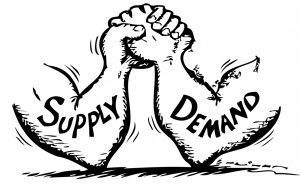
The eggnog may have been flowing a little more freely than normal this holiday season with vendors drowning their sorrows after one of the toughest selling seasons in over a decade.
Buyers in Melbourne and Sydney dragged down the combined capital city clearance rate in mid-December to a meagre 40 percent. This marked the lowest nationwide auction clearance rate on record, since CoreLogic began keeping tabs on auction statistics back in 2008.
Melbourne sellers managed to clear above 40 percent, but Sydney’s justifiably finicky buyers were only willing to meet seller reserves on 38.8 percent of properties. Last year over the same weekend, clearance rates in our two largest capitals were 65.9 percent and 52.7 percent respectively.
Not much seems to have changed in the new year, as the latest auction stats collected from the weekend just passed continue to show housing market weakness. The volume of listings is still quite low, so it wouldn’t be prudent to read too much into the numbers. That said, these early reports indicate that auction clearance rates remain twenty percentage points lower than the same weekend last year.
Here are the latest preliminary auction results:

Source: CoreLogic via Business Insider Australia
Once the final results are counted and reported this Thursday, expect the combined capital city clearance rate to sit around 42 or 43 percent, only marginally better than when the property market wound down in December.
Lower Still?
As referenced last month, auction clearance rates below 50 percent are generally consistent with falling dwelling prices. Until demand increases relative to supply, we should expect to see Melbourne and Sydney real estate values continue to correct. Our other capital city markets, namely Adelaide, Brisbane, Canberra and Hobart, remain more resilient.
According to the latest data from CoreLogic, Melbourne dwelling values fell 1.60 percent in January, and Sydney is down 1.35 percent for the month. Perth continues to show weakness with a 1.0 percent decline in January. Our other larger capital city are all looking pretty stable and seem ripe for quick cash deals, if you can get in and out relatively quickly.
While Melbourne and Sydney’s rolling twelve-month declines are 8.29 percent and 9.68 percent respectively, Adelaide, Canberra and Hobart all remain in positive territory for the year.
If you refer to CoreLogic’s back series of data, you can uncover just how far prices have fallen in Melbourne and Sydney since their peaks. Sydney house prices topped out first, back in July 2017, and have since fallen 12.35 percent. Melbourne was four months behind, with dwelling values there having now fallen a total of 8.70 percent since November 2017.
This means life is getting difficult for many who bought properties in the second half of 2017.
Property buyers in Sydney around winter 2017 on a 90 percent LVR is now in negative equity, having lost all their deposit (not to mention stamp duty and legals). Melbourne buyers who saddled up debt that spring are approaching a similar predicament.
Economist Martin North from Digital Finance Analytics recently posted a video explaining how he worked out which suburbs around the country are likely to have the greatest concentration of households in negative equity.
The hotspots for mortgage stress happen to be the suburbs with a large number of newly constructed homes, especially those that are higher density. These tend to be either land releases in the outer fringes of Sydney and Melbourne or postcodes with a significant number of recently constructed apartment buildings.
I seem to recall Steve McKnight saying something about not buying off the plan properties.
Here’s CoreLogic’s latest monthly median house price data:
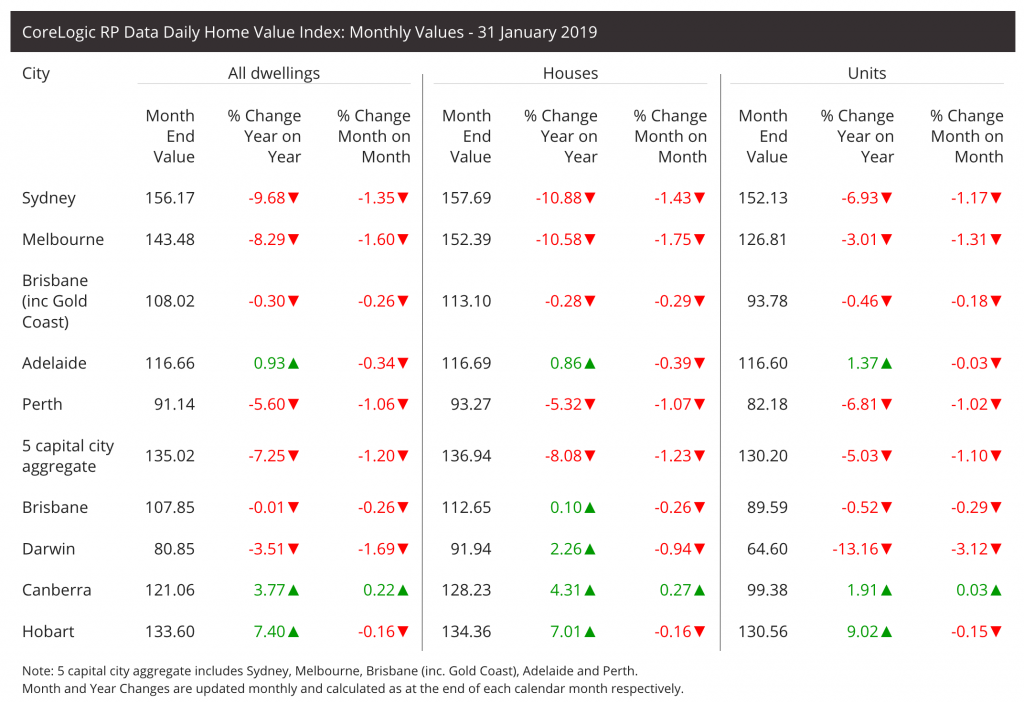 Source: CoreLogic
Source: CoreLogic
In the News…
The U.S. Federal Reserve Just Signalled a Massive Shift
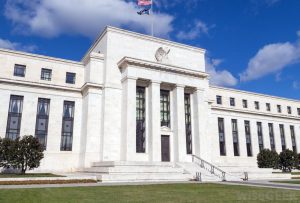 For the last few years, the Fed has been aggressively raising interest rates after a decade near 0 percent. Until last week, Fed Chairman Jerome Powell had been signalling an ongoing tightening policy, suggesting as many as four rate-rises through 2019.
For the last few years, the Fed has been aggressively raising interest rates after a decade near 0 percent. Until last week, Fed Chairman Jerome Powell had been signalling an ongoing tightening policy, suggesting as many as four rate-rises through 2019.
That all changed last week with the Fed’s decision to leave rates on hold. After the monetary policy announcement, Jerome Powell shared a few words, signalling a more dovish outlook. Here are a few of the highlights from his speech:
“The case for raising rates has weakened somewhat.”
“In light of global economic and financial developments and muted inflation pressures, the Committee will be patient as it determines what future adjustments to the target range for the federal funds rate may be appropriate.”
“I would want to see a need for further rate increases, and for me a big part of that would be inflation.”
Looking back at the last 62 years of interest rates in the United States, it appears that we may have now reached the top of a downward trend and are due for another series of rates cuts. Have a look at the chart below.
Federal Funds Rate – 62 Year Historial Chart
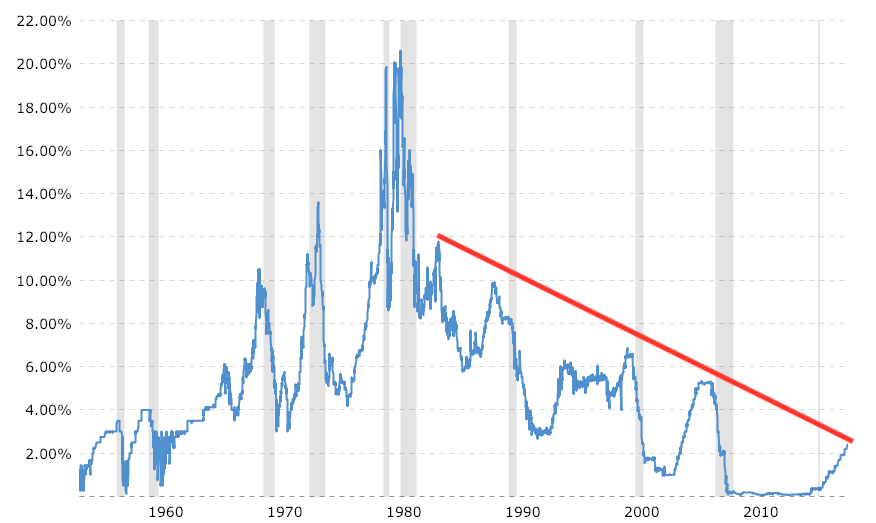
Unless inflation picks up considerably in the United States, more rate rises there seem unlikely. If the share market keeps falling, or bond prices fall, it wouldn’t surprise me to see the Fed cut rates again.
The RBA Still on Hold, But for How Long?
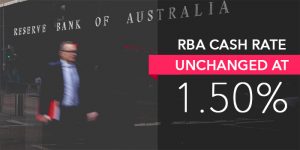 The RBA Board met yesterday and decided to leave the cash rate on hold for a 30th consecutive month.
The RBA Board met yesterday and decided to leave the cash rate on hold for a 30th consecutive month.
If we have indeed seen a cycle peak in US interest rates (as indicated in the chart above), this policy shift has significant relevance for the Australian economy, the RBA, and property investors here in Australia.
As I’ve written in previous months, the Fed rate hikes have put increasing pressure on Aussie banks to lift variable mortgage interest rates, due to wholesale lending costs rising in line with the Fed funds rate.
Australian borrowers can now breathe a sigh of relief as the threat of rising interest rates seems to have abated for now.
On the other hand, higher borrowing costs in the US have benefited Australian exporters. When the Fed lifts rates, and the RBA holds (or cuts), the Aussie dollar tends to get weaker relative to the Greenback. This makes Aussie products less expensive for people overseas paying with US dollars. But for those of us buying goods from overseas, it means we fork out more cash.
Now that the Fed is no longer raising rates, we could see some upward pressure on the Aussie dollar. This increases the likelihood of an RBA rate cut aimed at devaluing our currency in hopes of spurring economic growth here at home.
In fact, the RBA has just downgraded its inflation forecast yet again, down to 2 percent this year from 2.25 percent. Philip Lowe is also coming across a little more concerned about the downturn in house prices. Could he be setting up a case for a rate cut?
In addition to improving the inflation data, an RBA rate cut or two would also bring some relief to variable rate mortgage holders, so long as the banks are kind enough to pass these savings along to consumers. In light of how the Royal Commission has dragged the names of the big banks through the mud, that may be just what bank executives need to rebuild some goodwill.
Building Approvals Haven’t Looked This Bad Since the GFC
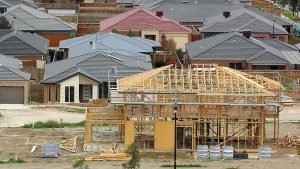 Here’s another reason Philip Lowe may be nervous.
Here’s another reason Philip Lowe may be nervous.
Australian building approvals just copped the biggest annual drop over back-to-back months in nearly ten years. It was bad enough that dwelling permits were down 22.5 percent in December from a year earlier, but that was after diving 33.5 percent in November from the previous twelve months.
The primary reason for this drop is because significantly fewer developers are willing or able to fund new projects. Either they’re nervous about future demand or they can’t get the money to acquire sites and break ground.
With less construction, that means less money flowing through the huge building and real estate industry as a whole, negatively impacting builders, tradies and suppliers. Even Bunnings could take a big hit. All of this could set off a chain reaction leading us into our next recession.
As much as investors in Brisbane, Adelaide, Canberra and Hobart hate to admit, they are not necessarily immune to the deflating housing bubbles in Sydney and Melbourne.
How Kenneth Hayne Threw Mortgage Brokers Under the Bus
Yesterday, the final report from the banking royal commission was made public. The highlight of the event was no doubt that awkward photo opp between Kenneth Hayne and Josh Frydenberg.
Here are a few of the more salient points from Kenneth Hayne’s report; the ones I found to be most relevant to property investors:
- The current laws relating to lending practices are for the most part sufficient and don’t need to be changed, but they do need to be more effectively enforced.
- Mortgage brokers should be held accountable for acting in the best interests of borrowers rather than enhancing personal profit.
- Trailing commissions and lender-paid commissions represent a conflict of interest for mortgage brokers. These broker commissions should stop being paid on new loans from 1 July 2020 and the decision should be reviewed again in three years.
- From 1 January 2021, all grandfathered commissions to mortgage brokers should cease and henceforth be rebated to clients.
- A standardized measure of borrowing expenses, like the Household Expenditure Measure (HEM), is not altogether inappropriate, but it needs to be based on a much more reasonable level so as not to underestimate expenses.
- Lenders should still be responsible to make some specific enquiries to verify actual household expenditures.
While there were plenty of smacks on the wrist for banks in the report, it seems that mortgage brokers have become the scapegoat for sins of the mortgage lending industry.
Lindsay David from LF Economics suggested this would be the case:
From an oped I wrote just before the #bankingRC started on how mortgage brokers would be thrown under a bus https://t.co/GkiyND0KBv pic.twitter.com/2x1zDAGDPy
— Lindsay David (@linzcom) February 4, 2019
It’s hard to see how the mortgage broker industry will survive if the government legislates these suggestions. It’s a shame. The way I see it, mortgage brokers have only been helping their clients get the best deals, and operate within the boundaries set by the banks. After all, a broker can’t help a client get a loan larger than what the bank will approve.
What does it all mean for property investors?
 Regarding the royal commission, I don’t see anything in Kenneth Hayne’s report to suggest that credit in the housing market will start to flow any more freely. The bar will be raised on any standardised measures of household expenses and lenders will continue to peer into borrower bank accounts to validate serviceability.
Regarding the royal commission, I don’t see anything in Kenneth Hayne’s report to suggest that credit in the housing market will start to flow any more freely. The bar will be raised on any standardised measures of household expenses and lenders will continue to peer into borrower bank accounts to validate serviceability.
That means the current challenges borrowers are having proving their worth will likely continue. Unfortunately, at some point, you’ll be doing it without the help of an independent broker to get you the best deal – unless of course, you’re willing to pay for the service yourself.
But investors shouldn’t throw in the towel. While some may choose to sit on the sidelines seeing more risk than reward, many investors are still making money.
I have clients who recently finished or are currently working on profitable manufactured growth deals in Adelaide, Newcastle, Brisbane, Canberra, and even Geelong. If you know what to look for and you’re willing to develop new skills, there’s still money to be made in property.
Comments
Got something to say? Post a comment...
You must be logged in to post a comment.


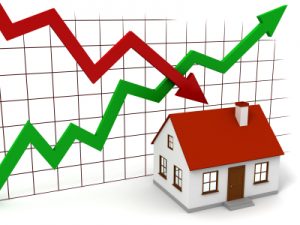




Boo Hoo!! My heart bleeds for those poor people in Melbourne and Sydney feeling less optimistic about things after leverages themselves to the ying yang!
Unfortunately, it’s not just their problem. Their demise could be painful for the entire country. A lot is riding economically on the health of the Melbourne and Sydney property markets.
Hi Jason, really long and detailed article, made some good points there about the restrictions and in particular the mortgage brokers law and how that will affect their business, good point saying how they have copped some of the punishment/blame for the incompetence of the banks. I have a feeling that the RBA may lower the rates as you say, there’s been talks about it for a while and with the economy having stagnated for as long as it has been, their growth projection being lowered from 2.25% to 2% may just be the clincher, I feel they would want the household debt levels and financial stress to reduce and more money to flow through the economy to boost the percentage growth, although that depends what the households actually do with the potential reprieve.
True, Sam. The problem with lower interest rates though is it would encourage more household debt unless the RBA can direct the additional credit into productive businesses using it for capital investment. I’m not sure providing a little more spending money to households will bring the desired boost to the economy. Time will tell.
Well they have tighted the lending, if they inforced (or lenders looked under the skirt before acting) then we would have a different landscape.
I think stagnate housing market over the next few years isn’t a bad thing for the Country, as long as we still sustain the same population growth and have jobs from development then sounds fine to me,
your thoughts mate?
Hey Jaxon. Yeah, I agree. For sustainable long-term growth, we really need house prices to come back into line with wages, especially in Sydney/Melbourne. I thing what you propose is the RBA’s best case scenario – flat property market and inflation (wages not just consumer prices). At 3% per annum growth in wages, we’d need a stagnant market for about 8 years to bring things back in line. That would erode all the buying power of recent gains though, so not an ideal period to be holding if that plays out.